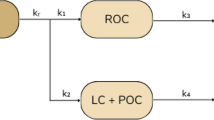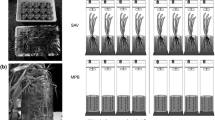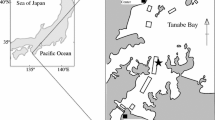Abstract
The turnover and exchange rates, as well as the diffusion processes, concerning the input and output of carbon compounds at the mud-water interface, were studied. The carbon input rates were derived from the annual sedimentation rates of particulate organic matter (about 1 100 kg C · yr−1). The nature of the sedimented POC, and its breakdown pathways and turnover rates towards important metabolic intermediates in methanogenesis, were examined. The breakdown kinetics ofChlorella cell walls, a dominant green alga in Lake Vechten, was studied using U-14C-labelled cell walls. The breakdown of the cell walls appears to the rate-limiting step in anaerobic mineralization.
Using first order kinetic equations, and HPLC and GLC and radio-chemical methods, turnover rate constants (k-values) of between 0.18 and 0.32 day−1 and pool sizes of algal cell walls of 37 to 80 μg · g−1 wet mud were found, giving turnover rates of 7.7 to 25.6 μg · g−1 · day−1 of cell wall material. The turnover rates (k-values between 0.07 and 0.31 h−1) of acetate, the most important breakdown product, and its concentration gradients (between 5 and 30 μmol) and diffusion coefficient (Ds = 2.2 × 10−6 cm2 · s−1) just in and above mud-water interface, was quantified. The diffusion of acetate, within the sediments, could not account for the turnover rates observed.
Finally, from acetate flux data and from those on the rates of formation of carbon dioxide and methane, the output of carbon and its cycling in Lake Vechten are discussed.
Similar content being viewed by others
References
Berner, R. A., 1980. Early Diagenesis, a Theoretical Approach. Princeton University Press, Princeton, N.J. 241 pp.
Best, E. P. H., Blaauboer, M. C. I., Cappenberg, Th. E., Gons, H. J., Gulati, R. D., de Kloet, W. A., Steenbergen, C. L. M. & Verdouw, H., 1978. Towards an integrated study of the ecosystem of Lake Vechten. Hydrobiol. Bull. 12: 107–118.
Blaauboer, M. C. I., Van Keulen, R. & Cappenberg, Th. E., 1982. Extracellular release of photosynthetic products by freshwater phytoplankton populations, with special reference to the algal species involved. Freshw. Biol. (in press).
Cappenberg, Th. E., 1976. Methanogenesis in the bottom deposits of a small stratifying lake. In: Schlegel, H. G., Pfennig, N. & Gottschalk, G. (Eds.) Microbial Production and Utilization of Gases, H2, CH4, CO, pp. 125–134. E. Goltze-Verlag, Göttingen.
Cappenberg, Th. E., 1980. Use of radio gas chromatography in studying breakdown processes of organic matter in aquatic ecosystems. In: Agrochemical Residue-Biota Interactions in Soil and Aquatic Ecosystems, pp. 55–66. International Atomic Energy Agency, Vienna.
Cappenberg, Th. E. & Prins, R. A., 1974. Interrelations between sulfate-reducing and methane-producing bacteria in bottom deposits of a fresh-water lake: III. Experiments with14C-labeled substrates. Antonie van Leeuwenhoek 40: 457–469.
Cappenberg, Th. E. & Jongejan, E., 1978. Microenvironments for sulfate reduction and methane production in freshwater sediments. In: Krumbein, W. E. (Ed.) Environmental Biogeochemistry and Geomicrobiology, Vol. 1, pp. 129–138. Ann Arbor Sci. Publ., Ann Arbor.
Crank, J., 1967. The Mathematics of Diffusion. Oxford University Press, Oxford. 347 pp.
Gasith, A., 1967. Seston dynamics and tripton sedimentation in the pelagic zone of a shallow eutrophic lake. Hydrobiologia 51: 225–231.
Hordijk, C. A. & Cappenberg, Th. E., 1982. Quantitative H PLC — Fluorescence determinations of some important low-molecular-weight Fatty Acids in mud samples, in comparison with other methods. Geochim. cosmochim. Acta (submitted).
Kelly, C. A. & Chynoweth, D. P., 1980. Comparison of in situ and in vitro rates of methane release in freshwater sediments. Appl. envir. Microbiol. 40: 287–293.
Klump, J. V. & Martens, C. S., 1981. Biochemical cycling in an organic-rich coastal marine basin—II. Nutrient sedimentwater exchange processes. Geochim. cosmochim. Acta 45: 101–121.
Kimmel, B. L. & Goldman, C. R., 1977. Production, sedimentation and accumulation of particulate carbon and nitrogen in a sheltered subalpine lake. In: Golterman, H. L. (Ed.) Interactions between Sediments and Freshwater, pp. 148–155. Dr. W. Junk, The Hague.
Martens, C. S. & Klump, J. V., 1980. Biochemical cycling in an organic-rich coastal marine basin—I. Methane sedimentwater exchange processes. Geochim. cosmochim. Acta 44: 471–490.
Molongoski, J. J. & Klug, M. J., 1980. Anaerobic metabolism of particulate organic matter in the sediments of a hypereutrophic lake. Freshwat. Biol. 10: 507–518.
Parma, S., 1971. Chaoborus flavicans (Meigen) (Diptera, Chaoboridae): an autoecological study. Ph.D. thesis, Rijksuniversiteit Groningen. 128 pp.
Sansone, F. J. & Martens, C. S., 1981. Methane production from acetate and associated methane fluxes from anoxic coastal sediments. Science 211: 707–709.
Strayer, R. F. & Tiedje, J. M., 1978. Kinetic parameters of the conversion of methane precursors to methane in a hypereutrophic lake sediment. Appl. envir. Microbiol. 36: 330–340.
Verdouw, H. & Dekkers, E. M. J., 1982. Nitrogen cycle of Lake Vechten (The Netherlands); role of sedimentation. Arch. Hydrobiol. (in press).
Winfrey, M. R. & Zeikus, J. G., 1979. Microbial methanogenesis and acetate metabolism in a meromictic lake. Appl. envir. Microbiol. 37: 213–221.
Author information
Authors and Affiliations
Rights and permissions
About this article
Cite this article
Cappenberg, T.E., Hordijk, K.A., Jonkheer, G.J. et al. Carbon flow across the sediment-water interface in Lake Vechten, The Netherlands. Hydrobiologia 91, 161–168 (1982). https://doi.org/10.1007/BF00940106
Issue Date:
DOI: https://doi.org/10.1007/BF00940106




